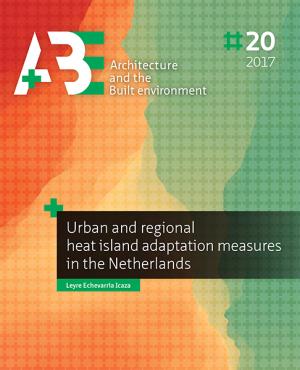Hosted by
Urban and regional heat island adaptation measures in the Netherlands
Synopsis
The urban planner´s role should be adapted to the current globalised and overspecialised economic and environmental context, envisioning a balance at the regional scale, apprehending not only new technologies, but also new mapping principles, that allow obtaining multidisciplinary integral overviews since the preliminary stages of the design process. The urban heat Island (UHI) is one of the main phenomena affecting the urban climate. In the Netherlands, during the heat wave of 2006, more than 1,000 extra deaths were registered. UHI-related parameters are an example of new elements that should be taken into consideration since the early phases of the design process.
PROBLEM STATEMENTThus, the development of urban design guidelines to reduce the heat islands in Dutch cities and regions requires first an overall reflection on the heat island phenomenom (relevance of the large scale assessment, existing tools, instruments) and proposal of integrative and catalysing mapping strategies and then a specific assessment of the phenomenom at the selected locations in The Netherlands (testing those principles).
MAIN RESEARCH QUESTIONCould the use of satellite imagery help analyse the UHI in the Netherlands and contribute to suggest catalysing mitigation acions actions implementable in the existing urban context of the cities, regions and provinces assessed?
METHODThe development of urban design principles that aim at reaching a physical balance at the regional scale is critical to ensure a reduction of the UHI effect. Landsat and Modis satellite imagery can be analysed and processed using ATCOR 2/3, ENVI 4.7 and GIS, allowing not only a neighbourhood, city and regional scale assessment, but also generating holistic catalysing mapping typologies: game-board, rhizome, layering and drift, which are critical to ensure the integration of all parameters. The scientific inputs need to be combined not only with other disciplines but often also with existing urban plans. The connection between scientific research and existing agreed visions is critical to ensure the integration of new aspects into the plans.
RESULTSAt the neighbourhood level the areas that have a greater heat concentration in the cities of Delft, Leiden, Gouda, Utrecht and Den Bosch are the city centres characterised by their red ceramic roof tiles, brick street paving, and canals. Several mitigation strategies could be implemented to improve the UHI effect in those areas; however, since the city centres are consolidated and listed urban areas, the mitigation measures that would be easier to implement would consist in improving the roof albedo. A consistent implementation of albedo improvement measures (improving the thermal behaviour not only of flat roofs, but also of tiled pitched roofs) of all roofs included in the identified hotspots (with an average storage heat flux greater than 90 W/m2) would help reduce the temperatures between 1.4°C and 3°C. Pre-war and post-war compact and ground-based neighbourhoods present similar thermal behaviour of the surface cover, and green neighbourhoods and small urban centres also present similar thermal behaviour.
At the city scale the analysis of 21 medium-size cities in the province of North Brabant, which belongs to the South region of the county -in relative terms the most affected by the UHI phenomenon during the heat wave of 2006-, reveals that albedo and normalised difference vegetation index (NDVI) are the most relevant parameters influencing the average nightime land surface temperature (LST). Thus, imperviousness, distance to the nearest town and the area of the cities do not seem to play a significant role in the LST night values for the medium-size cities analysed in the region of North Brabant, which do not exceed 7,700 ha in any case. The future growth of most medium-size cities of the regions will not per se aggravate the UHI phenomenon; in turn it will be the design of the new neighbourhoods that will impact the formation of urban heat in the province.
The average day LST of provincial parks in South Holland varies depending on the land use. The analysis of the average night LST varies depending of the land use of the patches. The following surfaces are arranged from the lowest to the highest temperatures: water surfaces, forests, cropland, and greenhouse areas. For each of these land uses, NDVI, imperviousness and landscape shape index (LSI) shape index influence the thermal behaviour of the patches differently. NDVI is inversely correlated to day LST for all categories, imperviousness is correlated to day LST for all areas which do not comprise a significant presence of greenhouses (grassland and built patches) and inversely correlated to LST for areas with a high presence of greenhouses (cropland and warehouses). Greenhouse surfaces have highly reflective roofs, which contribute to the reduction of day LST. Finally, landscape shape index varies depending on the nature of the surrounding patches, especially for small patches (built areas, forests and greenhouse areas). When the patches analysed are surrounded by warmer land uses, slender and scattered patches are warmer, more compact and large ones are cooler. In turn, when they are surrounded by cooler patches it is the opposite: slenderer and scattered patches are cooler and more compact and larger ones are warmer. In Midden-Delfland (1 of the 6 South Holland provincial parks), most of the hotspots surrounding the park are adjacent to grassland patches. The measure to increase the cooling capacity of those patches would consist in a change of land use and/or an increase of NDVI of the existing grassland patches.
CONCLUSIONSSatellite imagery can be used not only to analyse the heat island phenomenom in Dutch neighbourhoods, cities and regions (identify neighbourhoods with highest surface temperature, identify impact of city size and morphology in surface temperature, calcuate average surface temperature for different land uses…), but also to suggest mitigation actions for the areas assessed. Moreover, satellite imagery is here used to generate catalysing mapping typologies: game-board, rhizome, layering and drift, ensuring that the measures proposed remain accurate enough to actualy be efficient and open enough to be compatible with the rest of urban planning priorities.

